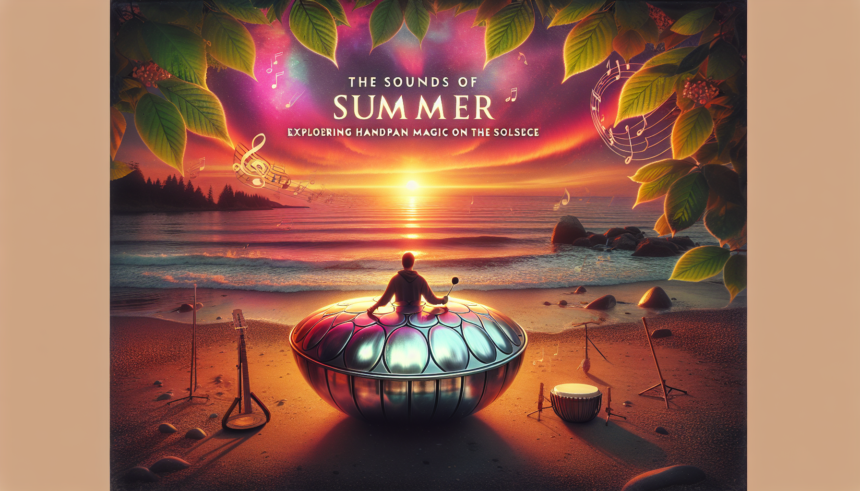As the days grow longer and the warmth of the sun intensifies, there exists a unique moment in time where nature itself seems to sing. The summer solstice, the longest day of the year, is celebrated around the globe with music, dance, and ritual. It is in this glorious backdrop that the enchanting sounds of the handpan find their place, merging the magic of the earth and sky into a symphony of steel and melody. In this article, we delve into the enigma of the handpan, its origins, significance, and the profound experience of playing and listening to this mystical instrument during the summer solstice.
The Enigmatic Handpan: Origins and Appeal
The handpan, often described as a rare and otherworldly instrument, originally surfaced in the early 2000s. This instrument was created by Felix Rohner and Sabina Schärer of PANArt in Switzerland. The handpan, also known as the Hang, is crafted with a dome-like shape from two metal half-shells that are glued together. The instrument’s surface features carefully structured tone fields or note areas, which produce ethereal, harmonic sounds when struck lightly with the hands.
What makes the handpan so intriguing is its ability to resonate with the listener on a deeply emotional level. The instrument’s sound is often described as soothing, meditative, and transcendental. While its roots are relatively contemporary, the handpan draws inspiration from various traditional instruments, such as the steelpan from Trinidad and Tobago, the ghatam from India, and the udu from Nigeria.
The Summer Solstice: A Celebration of Light and Music
The summer solstice is a time-honored celebration of light and warmth. Cultures across the world mark this occasion with various festivities, often centered around the power of the sun and its life-giving properties. It is a time of renewal, reflection, and connection with nature. Music plays a central role in these celebrations, acting as a vessel for communal expression and spiritual connection.
The handpan, with its soothing and ambient tones, becomes a perfect companion to the solstice festivities. Its melodic reverberations seem to emulate the very essence of the season – a blend of tranquility, radiance, and profound beauty. Handpan gatherings and performances during the solstice create sacred spaces where participants can immerse themselves in the harmonious resonance of this extraordinary instrument.
The Magic of the Handpan: Playing from the Heart
Playing the handpan is a deeply personal and intuitive experience. Unlike many other instruments that require extensive technical training, the handpan allows individuals to explore their own unique musical expression with relative ease. The lack of a strict musical notation system means that players can let their creativity flow, crafting melodies that resonate with their innermost feelings and thoughts.
During the summer solstice, handpan players often gather in open spaces, allowing the sounds of the instrument to blend seamlessly with nature. The interplay of sunlight, wind, and birdsong enhances the ethereal quality of the handpan’s tones, creating an immersive and transcendent atmosphere. Whether played solo or as part of an ensemble, the handpan’s ability to evoke a sense of peace and wonder shining brightly during solstice celebrations adds an additional layer of enchantment to this already magical time.
Solstice Handpan Rituals: Connecting with Nature and Spirit
Incorporating the handpan into solstice rituals can deepen the sense of connection to both nature and spirit. The instrument’s enchanting sounds can serve as a powerful tool for meditation, facilitating a deeper state of consciousness and inner reflection. Many people find that playing or listening to the handpan during the solstice helps them align with the natural rhythms of the earth and tap into the universal energy that surrounds the planet.
One popular ritual involves creating a handpan sound bath during the solstice sunrise or sunset. Participants are invited to lie down or sit comfortably, allowing the ambient tones of the handpan to wash over them. This immersive experience can promote relaxation, release of stress, and a heightened sense of spiritual awareness.
The Community of Handpan Enthusiasts: A Global Phenomenon
The handpan has cultivated a vibrant and passionate community of enthusiasts worldwide. Social media platforms, forums, and gatherings have brought together players and listeners from diverse backgrounds, united by their love for this unique instrument. Handpan festivals and workshops are held across various countries, providing opportunities for individuals to connect, learn, and celebrate the instrument’s magic together.
The solstice often acts as a focal point for many handpan events, drawing enthusiasts to scenic locations for communal playing and listening sessions. These gatherings foster a sense of unity and shared purpose, as participants collectively contribute to the creation of beautiful, harmonious music that honors the spirit of the season.
Conclusion
The melding of the handpan’s magical sounds with the celestial wonder of the summer solstice creates a truly enchanting experience. The instrument’s ability to evoke deep emotions, its connection to ancient musical traditions, and its role in solstice rituals make it a perfect companion for this celebration of light, warmth, and renewal. Whether you are a seasoned player or a curious listener, embracing the handpan’s enchanting melodies during the solstice can deepen your connection to nature, spirit, and the universal energies that unite us all.
FAQs
1. What is a handpan?
A handpan is a modern instrument created in the early 2000s by Felix Rohner and Sabina Schärer of PANArt in Switzerland. It is crafted from two metal half-shells glued together, featuring tone fields on its surface that produce harmonic sounds when struck with the hands.
2. Why is the handpan often used in meditation and therapeutic settings?
The handpan’s soothing and ambient tones make it an ideal instrument for creating a tranquil and immersive atmosphere. Its harmonic sounds can promote relaxation, reduce stress, and facilitate a deeper state of meditation and inner reflection.
3. Can anyone learn to play the handpan?
Yes, the handpan is known for being intuitive and accessible, making it suitable for players of all skill levels. Unlike many other instruments, it does not require extensive technical training, allowing individuals to explore their own unique musical expression with relative ease.
4. How is the handpan connected to traditional instruments?
While the handpan is a relatively modern instrument, it draws inspiration from various traditional instruments such as the steelpan from Trinidad and Tobago, the ghatam from India, and the udu from Nigeria. Its design and sonic qualities reflect a fusion of these diverse musical traditions.
5. What makes the summer solstice a special time to play the handpan?
The summer solstice, being the longest day of the year, is a time of celebration, renewal, and connection with nature. The handpan’s enchanting sounds blend beautifully with this season’s energy, creating an immersive and transcendent atmosphere that enhances the solstice experience for both players and listeners.





